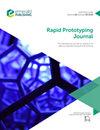Toward data-driven research: preliminary study to predict surface roughness in material extrusion using previously published data with machine learning
IF 3.6
4区 工程技术
Q1 ENGINEERING, MECHANICAL
引用次数: 0
Abstract
Purpose Material extrusion is one of the most commonly used approaches within the additive manufacturing processes available. Despite its popularity and related technical advancements, process reliability and quality assurance remain only partially solved. In particular, the surface roughness caused by this process is a key concern. To solve this constraint, experimental plans have been exploited to optimize surface roughness in recent years. However, the latter empirical trial and error process is extremely time- and resource consuming. Thus, this study aims to avoid using large experimental programs to optimize surface roughness in material extrusion. Design/methodology/approach This research provides an in-depth analysis of the effect of several printing parameters: layer height, printing temperature, printing speed and wall thickness. The proposed data-driven predictive modeling approach takes advantage of Machine Learning (ML) models to automatically predict surface roughness based on the data gathered from the literature and the experimental data generated for testing. Findings Using ten-fold cross-validation of data gathered from the literature, the proposed ML solution attains a 0.93 correlation with a mean absolute percentage error of 13%. When testing with our own data, the correlation diminishes to 0.79 and the mean absolute percentage error reduces to 8%. Thus, the solution for predicting surface roughness in extrusion-based printing offers competitive results regarding the variability of the analyzed factors. Research limitations/implications There are limitations in obtaining large volumes of reliable data, and the variability of the material extrusion process is relatively high. Originality/value Although ML is not a novel methodology in additive manufacturing, the use of published data from multiple sources has barely been exploited to train predictive models. As available manufacturing data continue to increase on a daily basis, the ability to learn from these large volumes of data is critical in future manufacturing and science. Specifically, the power of ML helps model surface roughness with limited experimental tests.迈向数据驱动的研究:利用先前发表的机器学习数据预测材料挤压表面粗糙度的初步研究
材料挤压是增材制造工艺中最常用的方法之一。尽管它的普及和相关的技术进步,过程可靠性和质量保证仍然只是部分解决。特别是,由该过程引起的表面粗糙度是一个关键问题。为了解决这一限制,近年来已经开发了实验方案来优化表面粗糙度。然而,后者的经验试错过程是极其耗时和资源消耗。因此,本研究旨在避免使用大型实验程序来优化材料挤压的表面粗糙度。设计/方法/方法本研究深入分析了几个打印参数的影响:层高、打印温度、打印速度和壁厚。所提出的数据驱动预测建模方法利用机器学习(ML)模型,根据从文献中收集的数据和为测试生成的实验数据自动预测表面粗糙度。使用从文献中收集的数据的十倍交叉验证,提出的ML解决方案获得了0.93的相关性,平均绝对百分比误差为13%。当用我们自己的数据进行测试时,相关性降低到0.79,平均绝对百分比误差降低到8%。因此,在基于挤压的印刷中预测表面粗糙度的解决方案提供了关于分析因素可变性的竞争性结果。研究局限/启示获得大量可靠数据存在局限性,并且材料挤压过程的可变性相对较高。原创性/价值虽然机器学习在增材制造中并不是一种新颖的方法,但使用来自多个来源的公开数据几乎没有被用来训练预测模型。随着可用的制造数据每天都在不断增加,从这些大量数据中学习的能力对未来的制造和科学至关重要。具体来说,机器学习的力量有助于用有限的实验测试来模拟表面粗糙度。
本文章由计算机程序翻译,如有差异,请以英文原文为准。
求助全文
约1分钟内获得全文
求助全文
来源期刊

Rapid Prototyping Journal
工程技术-材料科学:综合
CiteScore
8.30
自引率
10.30%
发文量
137
审稿时长
4.6 months
期刊介绍:
Rapid Prototyping Journal concentrates on development in a manufacturing environment but covers applications in other areas, such as medicine and construction. All papers published in this field are scattered over a wide range of international publications, none of which actually specializes in this particular discipline, this journal is a vital resource for anyone involved in additive manufacturing. It draws together important refereed papers on all aspects of AM from distinguished sources all over the world, to give a truly international perspective on this dynamic and exciting area.
-Benchmarking – certification and qualification in AM-
Mass customisation in AM-
Design for AM-
Materials aspects-
Reviews of processes/applications-
CAD and other software aspects-
Enhancement of existing processes-
Integration with design process-
Management implications-
New AM processes-
Novel applications of AM parts-
AM for tooling-
Medical applications-
Reverse engineering in relation to AM-
Additive & Subtractive hybrid manufacturing-
Industrialisation
 求助内容:
求助内容: 应助结果提醒方式:
应助结果提醒方式:


